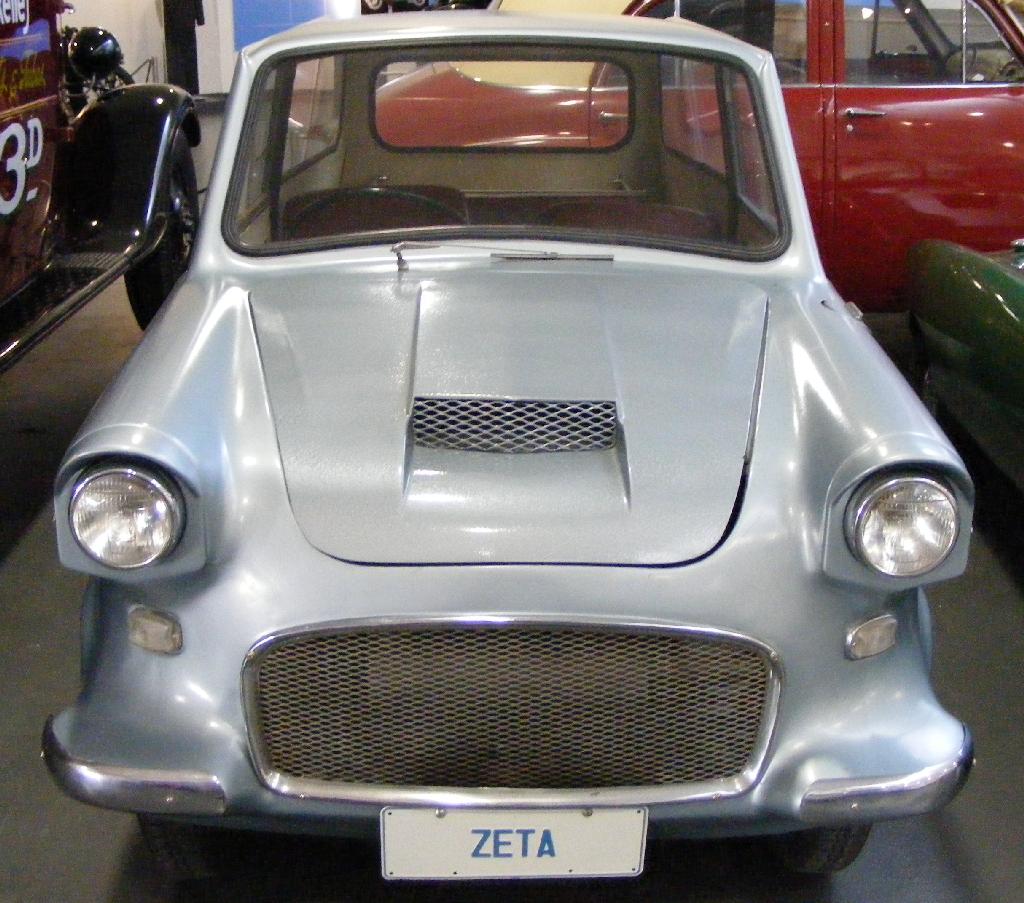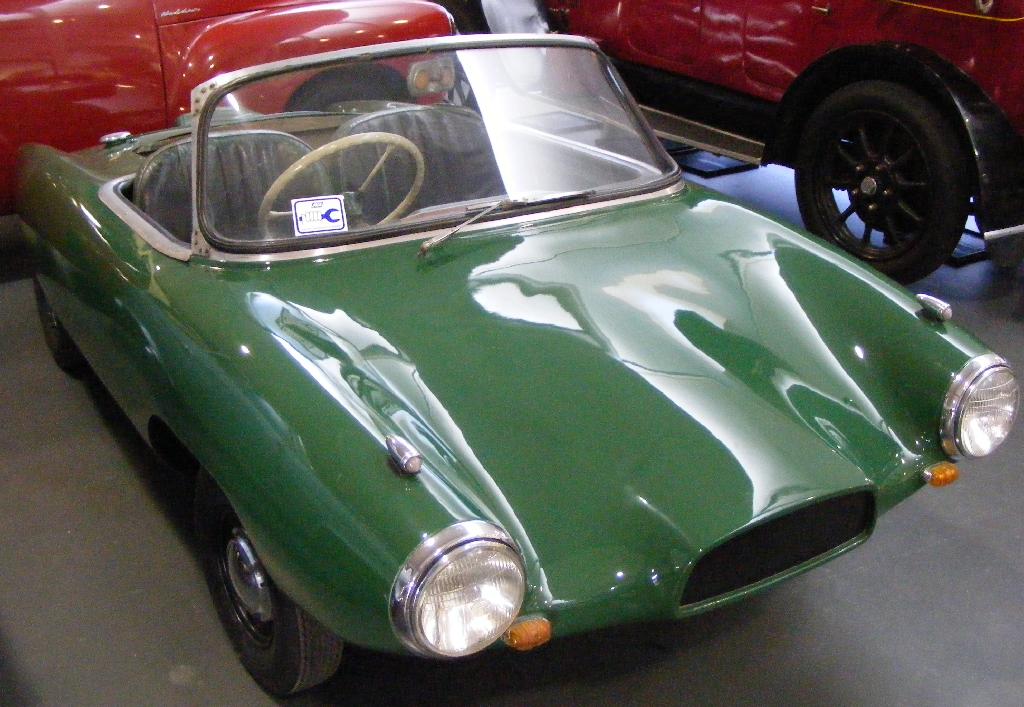Zeta (automobile) on:
[Wikipedia]
[Google]
[Amazon]
 Zeta is a marque of
Zeta is a marque of
 Zeta cars were produced in the following models:
Lightburn also produced an electric 'mobility-scooter esque' runabout vehicle capable of carrying 2 adults and available in two models.
Zeta cars were produced in the following models:
Lightburn also produced an electric 'mobility-scooter esque' runabout vehicle capable of carrying 2 adults and available in two models.
 As well as the oddness of the design, the vehicle's commercial success was also stymied by unfortunate timing as it was released onto the market at the same time as the Morris Mini, which was only £60 more expensive. As a result, only 363 vehicles were sold from 1963 to 1966, including 28 of the Sports model. According to a sign in the National Motor Museum in
As well as the oddness of the design, the vehicle's commercial success was also stymied by unfortunate timing as it was released onto the market at the same time as the Morris Mini, which was only £60 more expensive. As a result, only 363 vehicles were sold from 1963 to 1966, including 28 of the Sports model. According to a sign in the National Motor Museum in
National Museum of Australia: 1963 Zeta motor car
Cars of Australia Australian brands
 Zeta is a marque of
Zeta is a marque of automobile
A car or automobile is a motor vehicle with wheels. Most definitions of ''cars'' say that they run primarily on roads, seat one to eight people, have four wheels, and mainly transport people instead of goods.
The year 1886 is regarde ...
which was produced in Australia from 1963 to 1965 by South Australia
South Australia (commonly abbreviated as SA) is a state in the southern central part of Australia. It covers some of the most arid parts of the country. With a total land area of , it is the fourth-largest of Australia's states and territories ...
n manufacturing company Lightburn & Co.
An established manufacturer of cement mixers and washing machine
A washing machine (laundry machine, clothes washer, washer, or simply wash) is a home appliance used to wash laundry. The term is mostly applied to machines that use water as opposed to dry cleaning (which uses alternative cleaning fluids and ...
s, Lightburn and Co. built the cars in its factory in the Adelaide
Adelaide ( ) is the capital city of South Australia, the state's largest city and the fifth-most populous city in Australia. "Adelaide" may refer to either Greater Adelaide (including the Adelaide Hills) or the Adelaide city centre. The dem ...
suburb of Camden Park. The first Zeta model was introduced in 1963 at a price of £595. Production ceased in 1965 with the last vehicles sold in 1966 and total sales of fewer than 400 vehicles.
Models
 Zeta cars were produced in the following models:
Lightburn also produced an electric 'mobility-scooter esque' runabout vehicle capable of carrying 2 adults and available in two models.
Zeta cars were produced in the following models:
Lightburn also produced an electric 'mobility-scooter esque' runabout vehicle capable of carrying 2 adults and available in two models.
Features
Sedan and Utility
The Zeta Sedan, (also known as the Zeta Runabout) and Utility, were powered by a 324cc Villiers engine and were front wheel drive with independent rear trailing arms. The Sedan was not equipped with a rear hatch so access to the cargo area required removal of the front seats, the ease of which was advertised as a positive feature. The chassis was steel, with afibreglass
Fiberglass (American English) or fibreglass (Commonwealth English) is a common type of fiber-reinforced plastic using glass fiber. The fibers may be randomly arranged, flattened into a sheet called a chopped strand mat, or woven into glass clo ...
body enclosing a large but sparse interior. Windows were perspex except for the front windscreen which was laminated glass. The doors were steel with sliding perspex windows.
The tyres for the Sedan and Utility were Michelin 125 R12 as stated in the specifications. The four speed, dog clutch, Villiers Engineering
Villiers Engineering was a manufacturer of motorcycles and cycle parts, and an engineering company based in Villiers Street, Wolverhampton, England.
Early history
In the 1890s John Marston's Sunbeam had become extremely successful by relyin ...
gearbox had no reverse so the engine had to be switched off and started backwards which provide four reverse gears. Fuel was delivered by gravity feed from a tank behind the dashboard. The fuel gauge was a plastic pipe running from the top to the bottom of the tank with a graduated glass tube section on the dashboard. As a Wheels
A wheel is a circular component that is intended to rotate on an axle bearing. The wheel is one of the key components of the wheel and axle which is one of the six simple machines. Wheels, in conjunction with axles, allow heavy objects to b ...
road test in 1974 put it: "it read anywhere from full to empty depending on gradient, throttle and probably Greenwich mean time".
The Utility was the rarest of the Zeta models with a total of only 8 produced. A number were purchased by Sydney City Council
The City of Sydney is the local government area covering the Sydney central business district and surrounding inner city suburbs of the greater metropolitan area of Sydney, New South Wales, Australia. Established by Act of Parliament in 1842, th ...
's Hyde Park fleet. The Utility was mechanically identical to the Sedan.
Sports
The two-seater Zeta Sports was introduced in 1964.70 m.p.h. Zeta Sports Gives 44 m.p.g., Australian Motor Manual, July 1964 Body styling was based on theHenry Meadows
Henry Meadows, usually known simply as Meadows, of Wolverhampton, England were major suppliers of engines and transmissions to the smaller companies in the British motor industry. Founded in 1920 in Park Lane, Wolverhampton, as a car gearbox mak ...
Sprint version of the Frisky
Frisky may refer to:
* Frisky (automobile) a family of British microcars produced 1957-1964
* '' Frisky Tom'', a 1981 arcade game
* Mister Frisky, a racehorse
* ST ''Frisky'', a tugboat, previously the ''Empire Rita''
* "Frisky" (song), by Tin ...
microcar, designed by Gordon Bedson and Keith Peckmore, although Lightburn attributed the design to Michelotti. The fibreglass bodied car weighed and ran on 10-inch wheels with all-round drum brakes
A drum brake is a brake that uses friction caused by a set of shoes or pads that press outward against a rotating cylinder-shaped part called a brake drum.
The term ''drum brake'' usually means a brake in which shoes press on the inner surfac ...
. Like the Goggomobil Dart
The Goggomobil Dart was a microcar which was developed in Australia by Sydney company Buckle Motors, Buckle Motors Pty Ltd. and produced from 1959 to 1961.
The Dart was based on the chassis and mechanical components of the German Goggomobil micro ...
it lacked doors and bumper bars. The Zeta Sports was fitted with a West German ZF Sachs
ZF Sachs AG, also known as Fichtel & Sachs, was founded in Schweinfurt in 1895 and was a well-known German family business. At its last point as an independent company, the company name was Fichtel & Sachs AG.
In 1997, the automotive supplier wa ...
F.M.R. 500 498cc two cylinder, two-stroke
A two-stroke (or two-stroke cycle) engine is a type of internal combustion engine that completes a power cycle with two strokes (up and down movements) of the piston during one power cycle, this power cycle being completed in one revolution of ...
engine producing . The engine, which had a 70mm bore and a 67mm stroke was originally designed for and used in the 4 wheel FMR Tg500
The FMR Tg500 was a sports car built by Fahrzeug- und Maschinenbau GmbH, Regensburg (FMR) from 1958 to 1961. Based on the Messerschmitt Kabinenroller monocoque, which otherwise was a platform for three-wheelers, the Tg500 was a four-wheeled car w ...
microcar. The Zeta Sports was fitted with a 4 speed and reverse sequential gearbox in unit with the engine. 48 examples were produced.Don Luck, Zeta, Alternative Australian Motoring, Restored Cars No. 122, May–Jun 1997, page 22
Sales history
Birdwood, South Australia
Birdwood is a town near Adelaide, South Australia. It is located in the local government areas of the Adelaide Hills Council and the Mid Murray Council.
History Origin of the name
Birdwood was originally named ''Blumberg'', by Prussian s ...
, 48 of the sports model were manufactured.
References
External links
{{commonscat, Zeta by LightburnNational Museum of Australia: 1963 Zeta motor car
Cars of Australia Australian brands